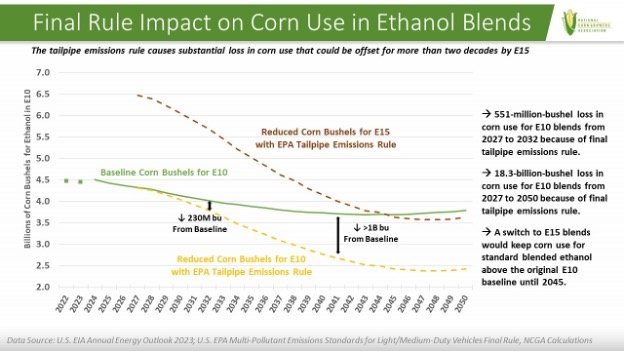The National Corn Growers Association reports new tailpipe emissions rules would be a “major shock on demand for corn used to produce ethanol” that could result in potentially devastating impacts on farmers and the rural economy.
EPA’s recently released final rule for multi-pollutant emissions standards for model years 2027 and later light-duty and medium-duty vehicles dictates that sales of non-electric vehicles will drop from over 92% of new vehicle sales in 2023 to under 30% of new vehicle sales in 2032 which translates to a 6.9-billion-gallon reduction in motor gasoline use in 2032, a 5.7% decline from the baseline projection for that year.
The rule’s requirement that drivers migrate to electric vehicles much faster than the market-driven adoption curve reflected in the baseline results in major declines in corn demand in a short period of time. U.S. corn growers would lose more than 550 million bushels of demand from 2027 to 2032 as compared to the baseline for E10 blends. As illustrated below, the annual loss in corn demand is over 1B bushels per year by 2041. That’s a loss of nearly a quarter of the total expected corn use in E10/E15 ethanol blends for this year.
The National Corn Growers Association has been advocating for movement to nationwide E15. While this wouldn’t change the tailpipe emissions ruling impact, it would provide much-needed relief to corn farmers. In fact, the move would increase corn used in E10/E15 blends by more than 2 billion bushels in 2027 and provide a long-term offset to the rule’s otherwise devastating hit to corn demand. It would also offer consumers lower fuel prices at the pump and provide a lower emissions product that can protect the environment during the vehicle transition.


